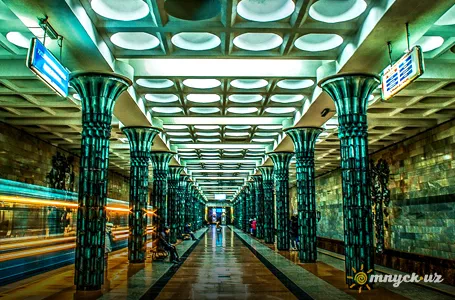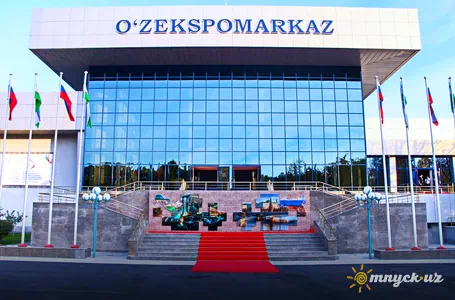Tashkent has a fairly large list of attractions that will take several days to visit. Architectural ensembles, mosques and minarets, museums and theaters, parks and galleries ... Here everyone can choose what to see and where to go!
* * *
Tashkent TV Tower – the visiting card of the capital

Each city has its own business card. The visiting card of Tashkent is already visible from afar, and one has to look at it from the bottom up. This is the Tashkent TV Tower – one of the most beautiful and tallest TV towers in Central Asia.
Built in 1957, the first 180-meter Uzbek television center could no longer fully cover the 4 millionth capital and the Tashkent region. It was necessary to increase radio and television broadcasting to remote mountainous areas.
By 1960, television and radio took a firm place in the cultural life of Uzbekistan. In a short time, preparations began for a new project for the TV tower. The task of the specialists was to build the tallest building in the whole of Central Asia and to solve all the tasks at the same time. The project was carefully studied and tested because the construction of such a high-rise was unprecedented. All necessary materials were studied, technological requirements and standards were observed, steel equipment was delivered from Germany. And finally, in 1978, construction began on a new TV tower, which took 6 years to build.
The authors of the project were Semashko Yu.P., Terziev-Tsarukov N.G., designers Morozov E.P. and Musheev M.D. The construction was carried out by specialists of the Vysotstroy trust.
The tower's pillars rise from a depth of 11 meters, resting on loose reinforced concrete foundations, creating a system capable of maintaining a very high balance.
The tower was built with a special crane capable of lifting 25 tons of cargo to a height of 240 meters. The TV tower is equipped with three high-speed Swiss elevators. On January 15, 1985, the state flag began to fly at the highest point of the building.
The height of the TV tower is 375 meters, and its long spire can be seen from anywhere in the city. the total weight of the structure is more than 6,000 tons. It is equipped with modern technology and equipment for radio and television broadcasting. Has more than a dozen workshops, television and radio stations in the Tashkent region.
The foyer of the TV tower is richly decorated with mosaic panels and models of the tallest towers in the world. The Tashkent TV tower takes the honorable 10th place among them.
Anyone can go up to the observation deck and, at an altitude of 110 meters, admire the breathtaking view of the city from a bird's eye view. There is also the Coinot restaurant, which has a special revolving platform. The restaurant has two halls: "Blue" in the national style and "Red" in the European style.
At night, the tower shimmers with thousands of lights and bewitches with its beauty and grandeur.
Tashkent TV Tower is a symbol of technological progress and human labor.
Eastern bazaar "Chorsu"

In the heart of the "Old City" (Eski Shahar) on the central square "Eski Juva" there is one of the main attractions of Tashkent - the huge Chorsu bazaar, known since the Middle Ages. Once at this bazaar, you find yourself in an oriental tale. Beauty on the shelves, abundance of goods, wide rows, friendly sellers. This is the whole history of Uzbekistan. You can endlessly list the variety of goods: skullcaps and national robes, scarves from national fabrics, ceramic and clay products, handmade souvenirs, gifts, oriental sweets, spices, fruits, vegetables and much more.
This largest bazaar arose around the 10th century and was located at the intersection of four shopping streets, which were an important center on the Great Silk Road. Trade here was conducted all year round and was intertwined with a wide variety of cultures. On the trade roads one could meet overseas merchants, caravan overpasses, shopkeepers, artisans, wealthy farmers and ordinary hard workers.
The market consists of several pavilions under blue domes: a grocery row, clothing rows, rows for the sale of carpets, blankets and mattresses, jewelry and artisan rows.
Of particular interest is the food pavilion, which is located under a large blue dome. The products are divided into types. The choice of dairy products is interesting, among which you should definitely try katyk (sour milk), kurt (dry fermented milk product, a variant of local cheese), syuzma (fermented milk product). The assortment of dried fruits scatters eyes. These are raisins, dried apricots, nuts, salted apricot seeds, peanuts in sugar and sesame. Eastern sweets - navat, parvarda, pashmak, halva, kozinaki. It is impossible to walk past rows of colorful spices and herbs: cinnamon, saffron, black and red peppers, nutmeg, cloves, cumin, coriander, caraway seeds, turmeric, dried vegetables.
Not far from the food pavilion, there are rows where you can taste national Uzbek dishes. Approaching the counters, from afar you can feel the indescribable aroma of pilaf, barbecue, samsa. Here you will find: naryn (cold noodles and broth), kazy (horse meat sausage), gumma, khasyp (homemade sausage), fried fish, khanum and manti, nakhat shurva (peas with lamb), lamb ribs. Even if you are not hungry, you will not be able to resist the Uzbek delicacies. You can try the dishes right in the cafe, or you can take it with you with a fresh Uzbek flatbread.
Chorsu Bazaar is a piece of history through the millennia.
Tashkent metro

Once in the capital of Uzbekistan, be sure to visit the Tashkent Metro. This is one of the main attractions of the city.
Each station of the Tashkent metro is an architectural and artistic masterpiece of various masters, a kind of excursion into the history of the peoples of Uzbekistan and a unique art gallery! Traditional patterns and sayings of sages, portraits of heroes, poets and thinkers, irreplaceable Uzbek mosaic ...
Chilanzar line. The construction of the metro began in 1973, and 4 years later the first line, Chilanzar, was opened. It originally consisted of 9 stations. Later in 1980, it was extended to 3 stations. Today the length of this line is 16.8 km and it goes from the south-west of the city through the center to the north-east.
Uzbekistan line. In 1984, 5 more underground stations of the new line - Uzbekistan – were opened. Within 8 years, 11 stations were opened on the Uzbekistan line, the length of which is 14.2 km. The Alisher Navoi station is a transfer to the Pakhtakor station of the Chilanzar line.
Yunusabad line. This line was opened during the years of independence of Uzbekistan in 2001. It has 6 underground stations. There are 2 transfer stations: "Ming Urik" to the station "Oybek" of the Uzbekistan line and "Yunus Rajabi" to the station "Amir Temur" of the Chilanzar line.
Overground metro. Construction of the Circle Line began on October 1, 2017. The length of the new line will be 52.1 km. Of these: 50.5 km were laid above the ground along a 6 m high overpass, and 1.6 km on the ground. The new metro line will consist of 35 stations. At the moment, 7 stations have been opened from the Dustlik station of the Uzbekistan line to the Kuylyuk market and 5 stations of the new Sergeli branch.
Multifunctional ice complex "Humo Arena"

Ice and Uzbekistan seem like incompatible things. But since the beginning of 2019, after the completion of the construction of the sports and entertainment complex "Humo Arena", it has become possible to attend matches, tournaments in hockey, curling, short track speed skating, figure skating. Since September 2019, regular matches of the Higher Hockey League championship have been held.
The Ice Palace impresses with its size, beauty, modern architectural solutions, versatility. It is built in the shape of the wing of the Humo bird of happiness. The complex meets all modern safety and equipment requirements and can accommodate 12,500 spectators.
Uzexpocentre

Uzexpocentre is a large exhibition complex in Tashkent, consisting of several pavilions. It is here that the most ambitious and largest not only republican, but also world exhibitions are held. A great place for interaction between government and business structures.
The building of "Uzexpocentre" is located on a large territory of the park. Walking in the park, you can enjoy the modern landscape, clean air, beautiful nature and a pond.
Not far from the center there are the "Japanese Garden", the "International" hotel, the "Plaza" art center, the "Tashkentland" culture and recreation park, which can be reached by metro.
Monument to the Shamakhmudov family

On one of the central squares of Tashkent "Friendship of Peoples" there is a monument erected in memory of the Shamakhmudov family.
The monument was opened in May 1982. The monument is dedicated to the heroic deed of the Shamakhmudov couple, who adopted 15 orphans of various nationalities during the Second World War.
During the years of Uzbekistan's independence, the monument was dismantled and moved several times - in April 2008 outside Tashkent, in the spring of 2017 to the capital's Friendship Park, and in May 2018, following an order from President Shavkat Mirziyoyev, it was returned to its original place – the Friendship of Peoples Square.
Monument "Courage" – a symbol of fortitude and heroism

In a difficult period of life, hundreds of thousands of people unite to support each other. A striking example of this is the Tashkent earthquake that occurred on April 26, 1966 at 05:23 local time.
The earthquake destroyed hundreds of houses. The center of Tashkent suffered the most. More than 300 thousand people were left homeless and lived in tents. Thanks to the friendly assistance of the union republics, almost the entire city was reconstructed, and new micro-districts were built. In honor of this event, on May 20, 1976, the Courage Monument was erected by sculptor and artist Dmitry Ryabichev. In his artistic image, he presented a black shattered cube of granite, symbolizing an earthquake, which depicts a dial with a clock and the date of the tragedy. The crack leads to the image of the family: a woman holding a child with one hand, and a man showing a repulsive gesture. Behind the monument, in a semicircle, there are bas-reliefs that serve as a background for it. They depict courageous people who selflessly helped to rebuild the city.
The Courage Monument is an important landmark of the city. The main idea of the monument is friendship, fortitude and courage of people. He conveys the strength of the spirit and the hope that all temporary difficulties will be overcome without fail. Newlyweds with flowers like to come here, as well as guests of the capital.
Tashkent – museums and theaters
Tashkent – historical monuments
Tashkent – mosques, churches
Tashkent – parks, squares, gardens
Samarkand – the crossroads of cultures
Bukhara – ancient and eternal
Khiva – a time portal to the past
Khorezm – country of a thousand fortresses

And find out about our new promotions, hotels, last minute tours, the best deals of the week!